HOUSE FLY
(This is a chapter from their most recent book, LaFontaine’s Legacy)
One of the things Gary wanted to accomplish was to have a fly for every possible fishing situation. One day he called Paul saying, “We’ve got to have a housefly.” Paul made the mistake of questioning Gary by saying, “The housefly is not aquatic.” Gary patiently explained to him that fish don’t just eat aquatic insects evidenced by the importance of grasshoppers, beetles, and other terrestrial insects as a food source. “But, houseflies?” questioned Paul even further.
Gary told him to try an experiment. Set a large pan of water outside overnight and see what would be in it in the morning. Besides a range of terrestrial insects Gary assured him that there would always be several common houseflies in the mix. After Paul ran the test he had to agree with Gary and the two set out to design a fly to fit the need.
About this time in the process Paul called us and Gretchen answered the phone. After the usual greetings he got down to business. What did we think a good body would be for a housefly? We didn’t have a clue but agreed to run the “water pan” experiment in our back yard and get back with him after we had caught some flies. In the meantime Paul and Char were chasing houseflies around their home trying to capture a couple to study live. Paul seemed to think imitating a live insect was more important than one that had drowned in a pan of water. He was right because some of the hairy fibers on their body seemed to disappear after a night in the water. At least that’s how it looked when we studied the wet critters we captured under our magnifying glass.
In time we agreed that peacock herl applied Double Magic style using Antron Touch Dubbing sounded like a good option to us but when Gary viewed the results he said the bodies had too much sparkle and sent us back to the drawing board. We tried reducing the amount of Touch Dubbing and got another refusal. Darn! This was almost like presenting a fly to a difficult spring-creek trout. Gary wasn’t buying what we had to offer. One of us finally suggested using a standard black, synthetic dubbing in place of the Antron Touch Dubbing but applying it Double Magic style. That’s what Gary was looking for; he rose to it on the first presentation. He later explained to us he was looking for fine hairs around the body rather than highlights the Antron produced. He was happy up to this point.
When we tied the fly on camera for him the wing just didn’t look right. Paul would put on a clump of Antron fibers and trim them to a rounded shape. Gary would look at them and again send us back to the drawing board. We discussed (and tried) several different ideas; less Antron but trimmed different. No! We even tried tying the bundles of Antron “spent style” and still Gary did not like the way the fly looked. Finally Gretchen suggested double, looped wings and that was the answer. Gary loved the look of the fly. We recorded the information and later included the House Fly on Volume V.
After all of the flies we filmed for Gary I have to admit there were two or three I never did try and the House Fly was one. When Gretchen and I were working on this chapter of this book I decided I should at least give the pattern a quick test to prove to myself it would fool a fish; Paul and Char were already converts.
Often in the evening Gretchen and I will enjoy a cup of coffee or a glass of iced tea while sitting next to our pond. Listening to the water run over the rocks and watching the Koi eat their dinner had a therapeutic, calming effect on us both. The pressures of the day would melt away while sitting there and talking with the babbling water as a background.
Ideas also came to mind under the same circumstances. I’m thinking, “I need to test the House Fly. Why travel all the way to the river. I have fish right here. Hum.” I also was very aware Gretchen protected “her fish” with a vengeance. I had decided that I’d better leave them alone when all of a sudden she decided to go to the store a couple of miles away to pick up something she forgot on her way home from work.
When I saw her pull out of the driveway I grabbed the “miniature fly rod” I often use to make “joke photographs” of a small fish so it would look bigger when placed beside it. I tied on a small House Fly, made my presentation, and Big Boy (Gretchen’s prize Koi) nailed it almost as soon as it hit the water. He would have run me into my backing except the pond was too small to allow that but I certainly did have a fight on my hands anyway.
I just about had that darned fish wore down to the point where I could release it when Gretchen walked in looking for the checkbook she forgot and caught me in the act. Darn! Too make a long story short, I made her “list” big time and it was less than good for me!
Regarding the pattern, I had to rate the fly a success (at least Big Boy loved it) but I figured any additional testing should be done somewhere further from home and retired the fly to a slot in the terrestrial box. If any of you have a “Koi Pond” in your yard, I recommend you test the House Fly somewhere AWAY from the home. In so doing your life will be much less complicated than mine is right now. Of course by the time you read these words, things should be better at my home; I hope!
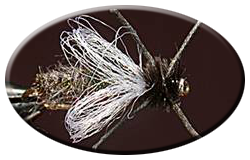
Materials:
- Hook: Size 14 to 18, 1x long standard dry fly
- Thread: Black
- Under body: Black foam, strip or cylinder
- Body: Peacock herl and black dubbing, Double Magic style
- Wing: Clear Antron, looped and separated
- Legs: Black Kevlar thread or fine rubber leg material
- Head: Black ostrich herl
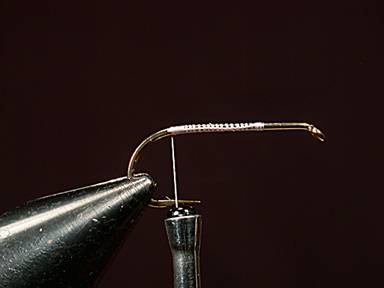 Step 1: Select a hook, place it in the vise, and cover the back two-thirds of the shank with a thread base. Leave it hanging at the back of the hook. Tying note: I’ve used gray thread, foam, and dubbing in the first three steps so it will show against the black background but be sure to use black materials on your pattern. I didn’t use a different color of peacock or ostrich herl because they seemed to have enough highlights to show well in the photograph.
Step 1: Select a hook, place it in the vise, and cover the back two-thirds of the shank with a thread base. Leave it hanging at the back of the hook. Tying note: I’ve used gray thread, foam, and dubbing in the first three steps so it will show against the black background but be sure to use black materials on your pattern. I didn’t use a different color of peacock or ostrich herl because they seemed to have enough highlights to show well in the photograph.
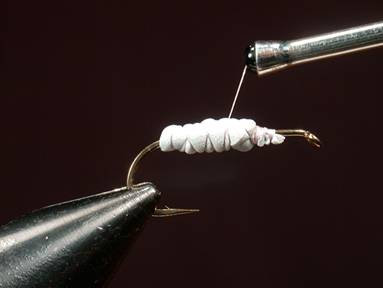 Step 2: Cut a strip of foam smaller in width than the hook gape and clip a point on one end. Tie this end to the back of the hook while advancing the thread to the one-third position. Wrap the foam forward to meet the thread, tie it off, and trim the surplus. Wrap back over the foam then forward using snug, not tight thread turns. Many tiers like to use a layer of super glue when they wrap a foam body, do so it you wish. OR slip a section of round foam on the hook and glue it into position; the choice is yours.
Step 2: Cut a strip of foam smaller in width than the hook gape and clip a point on one end. Tie this end to the back of the hook while advancing the thread to the one-third position. Wrap the foam forward to meet the thread, tie it off, and trim the surplus. Wrap back over the foam then forward using snug, not tight thread turns. Many tiers like to use a layer of super glue when they wrap a foam body, do so it you wish. OR slip a section of round foam on the hook and glue it into position; the choice is yours.
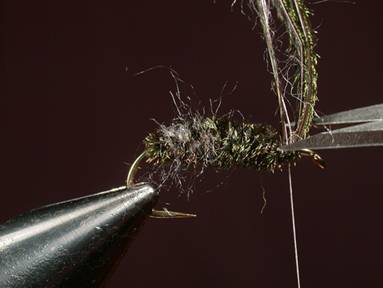 Step 3: Select several peacock herls and tie them to the top of the foam under body by their tips while wrapping to the back of the hook, then trim as needed. Pull the thread into a dubbing loop, place Super Tacky Wax on it, and touch (standard) black dubbing to it. Do not twist the dubbing material around the thread. Secure the peacock herl in the dubbing loop and spin the tool to twist the two materials (dubbing and herl) into chenille. Wrap the newly formed material over the foam, tie it off, and trim the waste to complete the body.
Step 3: Select several peacock herls and tie them to the top of the foam under body by their tips while wrapping to the back of the hook, then trim as needed. Pull the thread into a dubbing loop, place Super Tacky Wax on it, and touch (standard) black dubbing to it. Do not twist the dubbing material around the thread. Secure the peacock herl in the dubbing loop and spin the tool to twist the two materials (dubbing and herl) into chenille. Wrap the newly formed material over the foam, tie it off, and trim the waste to complete the body.
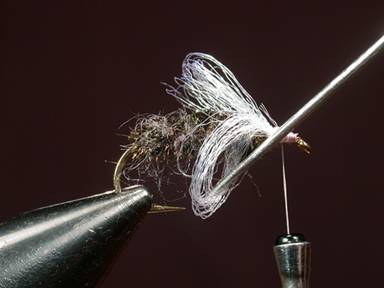 Step 4: Select a strand of clear Antron yarn, form it into a loop, and tie it to the hook to form a flat, Trude-style wing that is no longer than the end of the body. Use a bodkin to separate the loop into two wings.
Step 4: Select a strand of clear Antron yarn, form it into a loop, and tie it to the hook to form a flat, Trude-style wing that is no longer than the end of the body. Use a bodkin to separate the loop into two wings.
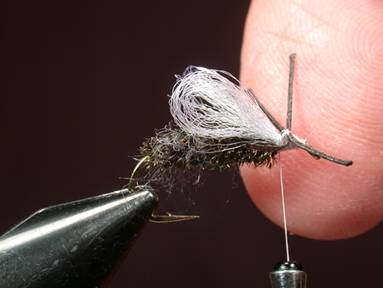 Step 5: Clip two sections of Kevlar thread (or other fairly stiff thread) from the spool and tie them to the hook to form four legs directly in front of the wings. Pull the legs all up together and trim them to length, about three-fourths of the length of the body.
Step 5: Clip two sections of Kevlar thread (or other fairly stiff thread) from the spool and tie them to the hook to form four legs directly in front of the wings. Pull the legs all up together and trim them to length, about three-fourths of the length of the body.
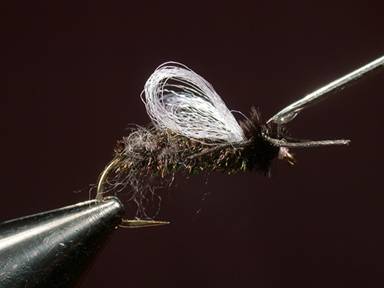 Step 6: Tie one black, ostrich herl on the shank behind the legs then finish binding it to the hook while wrapping the thread forward to meet the eye. Wind the herl forward making sure to figure-eight wrap it around the legs before finishing the head in front of them. Tie it off and trim the waste. A whip-finish and a drop of head cement completes the fly.
Step 6: Tie one black, ostrich herl on the shank behind the legs then finish binding it to the hook while wrapping the thread forward to meet the eye. Wind the herl forward making sure to figure-eight wrap it around the legs before finishing the head in front of them. Tie it off and trim the waste. A whip-finish and a drop of head cement completes the fly.
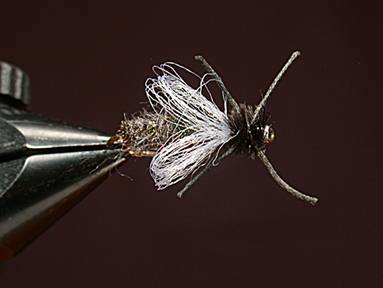 View from the top of the finished fly
View from the top of the finished fly
For more great info, check out:
Beginning Fly Tying | Intermediate Fly Tying | Advanced Fly Tying.
